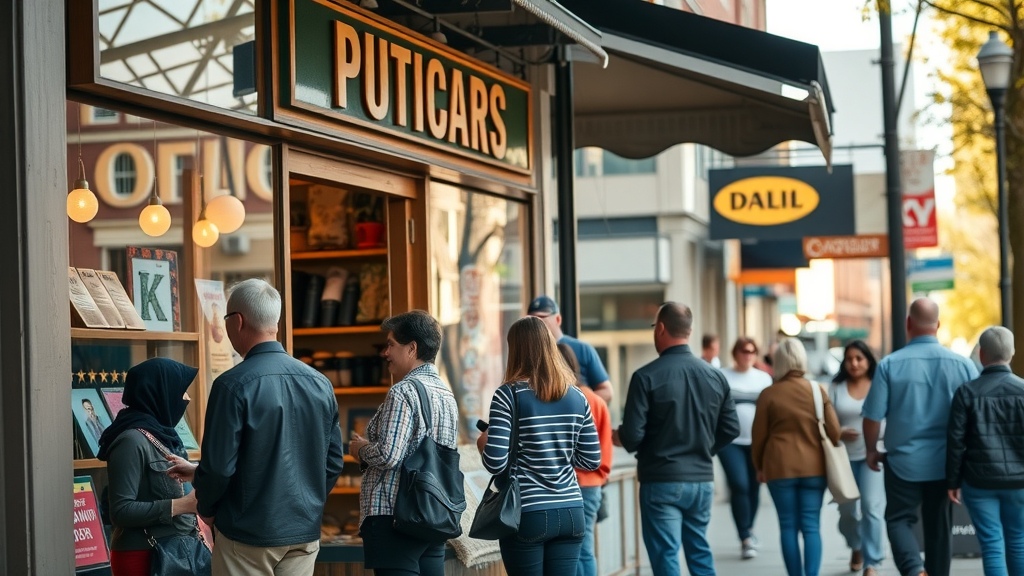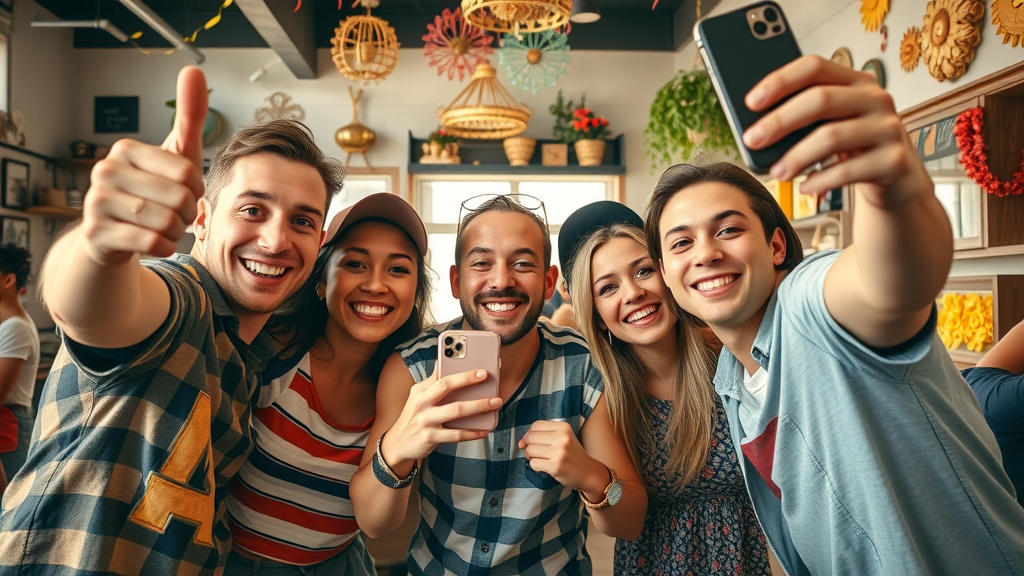Did you know that over 70% of small businesses experienced measurable growth this year by adopting new social media marketing local business approaches? In today’s digital world, local brands that harness the power of social media aren’t just surviving—they’re thriving and beating out their competitors. If you’re ready to transform your business visibility in 2024 and connect meaningfully with your local audience, this guide is tailor-made to deliver actionable strategies and case-backed advice you won’t want to miss.

- How social media marketing local business strategies work better than traditional ads
- Specific tactics for targeting, engaging, and growing your local customer base
- What kinds of posts and campaign plans drive real business results
- How to measure, optimize, and sustain success for your local brand
Why Social Media Marketing Local Business Approaches Outperform Traditional Advertising
Modern consumers spend more time than ever scrolling, commenting, and sharing on social platforms. For a local business owner, this is a golden opportunity to boost your media presence and cut through the noise— at a fraction of the cost of billboards or print ads . Social media marketing local business strategies create two-way communication, humanizing your brand and providing instant channels for feedback, promotions, or updates that resonate with your community.
Social media marketing doesn’t just build a following online—it’s a powerful marketing tool for driving foot traffic, generating buzz for events, and building lasting customer loyalty. Small businesses leveraging social media marketing are routinely seeing higher returns than those who stick to traditional advertising, especially as targeting techniques get more sophisticated. The difference? Social media marketing local business tactics are highly trackable, allowing you to see which posts, platforms, and creative approaches actually move the needle.
In practice, a media marketing strategy allows small businesses to join in on trending conversations, get noticed by their target audience, and respond to customer inquiries in real time. This agility and community focus can’t be matched by TV or radio ads. When marketing campaigns are tailored for local preferences and shared through a social media account, every dollar works harder and visibility increases dramatically.
Unpacking the Data: How Social Media Is Reshaping Local Business Success
Statistical studies show that social media marketing local business initiatives are outperforming traditional channels at every stage of the consumer journey. Platforms like Facebook, Instagram, and TikTok have made it seamless for local brands to target their exact audience based on geography, interests, and behavior. Media platforms now offer sophisticated measurement tools, making it easier for business owners to analyze what content works best for reaching and converting customers in their area.
According to a recent survey, more than 80% of shoppers check a local business’s social media account before making a purchase. This demonstrates just how critical an authentic, up-to-date social media presence is for small businesses today. Deploying creative social media posts, responding quickly to inquiries, and sharing real-time updates all contribute to reshaping a business’s public image and increasing visibility among locals.
“Over 70% of small businesses attribute recent growth to their social media marketing strategy—proving local impact is more powerful than ever.”

Essential Social Media Marketing Strategies for Local Business Growth
Success in social media marketing local business campaigns hinges on smart planning and targeted action. The most effective social media platforms offer tools for defining a target audience, building media presence, and scheduling engaging social media posts. Instead of spreading yourself thin, focusing on a curated approach tailored to your ideal customer delivers better results and faster growth for your media marketing strategy.
At the core, effective social media marketing for small businesses comes from knowing your local market and audience habits. This insight guides which media accounts to prioritize, how often to post, and the types of content that will generate the most engagement. By leveraging both organic and paid social options, local business owners can maximize reach, tap into new demographics, and build positive word-of-mouth that leads to repeat customers.
- Target audience definition for local businesses
- Choosing the right social media platforms for your business
- Crafting compelling social media posts
- Building a robust social media presence
- Leveraging media marketing strategy for small business success
How to Identify and Engage Your Local Target Audience
For any social media marketing local business plan, defining your target audience is the first crucial step. Start by mapping out demographic details—age, interests, geographic location, and common purchasing habits—specific to your community. Tools available within popular social media platforms like Facebook Audience Insights and Instagram Analytics allow business owners to track follower demographics and adjust strategies swiftly. The more precise your target audience profile, the more tailored and engaging your social media content can become.
Engaging your audience goes beyond broadcasting promotions. Local business owners benefit from two-way interactions—polls, Q&As, user-generated content, and sharing photos from community events. Reacting to and resharing local testimonials or hashtags builds trust and ensures your social media posts appear authentic. Remember, every reply and acknowledgment on your social network further solidifies your media presence among potential customers.
Finally, consider personalizing your marketing tool approach. Hosting community-centric campaigns, spotlighting local employees, and offering neighborhood-only deals can set you apart and encourage word-of-mouth. Staying active in community conversations, both online and offline, helps keep your brand top-of-mind for customers in your local area.

Selecting the Most Effective Social Media Platforms for Local Businesses
Choosing the best social media platforms is critical for maximizing engagement and return on investment. Not all networks are created equal when it comes to connecting with a local audience. Facebook and Instagram remain dominant for neighborhood businesses, offering powerful local targeting and event promotion features. For younger audiences or visual-heavy brands, TikTok and Snapchat are also proving to be popular social media platforms for community discovery.
LinkedIn can be a potent media platform for locally-focused B2B enterprises, while Pinterest works well for food, design, and fashion businesses aiming for high-visibility social media posts. Each social network has different strengths in terms of audience engagement, discovery algorithms, and paid social options. The smart approach for any local business owner is to evaluate which platforms align best with your marketing strategy, audience habits, and available resources.
The table below compares major social media platforms in terms of reach and engagement for local business growth in 2024:
| Platform | Audience Demographic | Local Targeting? | Best for Engagement | Recommended Usage |
|---|---|---|---|---|
| 25–55 | Yes | Events, Reviews, Groups | Neighborhood updates, community polls, promotions | |
| 18–40 | Yes | Visual Posts, Stories | Product showcases, influencer partnerships | |
| TikTok | 13–35 | Yes | Short Videos, Hashtags | Trendy community challenges, quick promotions |
| 25–54 | Limited | B2B Networking | Local business collaborations, talent recruiting | |
| 25–45 | No | Visual Discovery | Style guides, local event inspiration |
Crafting a Winning Social Media Marketing Local Business Strategy
Success in social media marketing local business efforts isn’t about posting on a whim—it’s about building a thoughtful, organized marketing strategy that aligns with community needs and business objectives. Begin by laying out clear goals, whether driving in-store traffic, generating leads, or increasing social media content engagement. Map out steps in your media marketing strategy, focusing on aligning marketing campaigns with real-life community trends to ensure resonance and timely relevance.
Next, it’s vital to maintain a consistent brand voice and look across all media accounts and social media platforms. Consistent branding fosters trust and recognition; from your logo to your tagline, every aspect of your identity should reinforce your business’s local values. Regular audits of your media accounts ensure there’s no drift in tone or visual presentation, no matter which social social network your audience finds you on.
- Steps to building your media marketing strategy
- Aligning marketing campaigns with local community trends
- Importance of consistent branding across media accounts and platforms

Content Calendars and Scheduling for Social Media Accounts
Organization is the cornerstone of a productive social media marketing local business approach. Crafting and sticking to a content calendar ensures you have a consistent stream of posts tailored to key dates, local events, and seasonal trends. Tools such as Buffer, Hootsuite, or even well-structured spreadsheets help business owners map out their social media post schedule weeks—even months—in advance, ensuring optimal frequency and variety.
When planning your media posts, be sure to mix informative, promotional, and entertaining content. Aligning social media content with community happenings—like county fairs or charity drives—keeps your media presence relevant and relatable. Advanced planning also enables local businesses to promote events or sales with enough lead time for substantial buzz, rather than scrambling at the last minute.
Routine review and adjustment are vital. Use analytics (more on this later) to identify which social media accounts and posts perform best, and recalibrate your content calendar accordingly. This data-driven approach helps maximize engagement and keeps your digital marketing efforts in sync with your customers’ actual preferences.
Mixing Organic and Paid Social for Maximum Reach
A balanced approach between organic and paid social media marketing is what sets successful local brands apart. Organic content builds genuine engagement, trust, and community conversation—think behind-the-scenes photos, spotlights on loyal customers, and day-in-the-life stories from your staff. Paid social posts and targeted ads, meanwhile, allow you to reach new, hyper-local audiences quickly and with surgical precision.
Running a small, strategic paid social campaign for a key promotion or event can turn a standard media post into a neighborhood sensation. With detailed local targeting options now available on nearly every major social media platform, even a modest budget can yield outsized results. Regular split testing of creatives and copy ensures that every dollar spent is moving you closer to your media marketing goals.
Ultimately, the synergy between organic and paid media marketing strategies allows you to cover more ground, respond quickly to shifts in the local market, and outperform competitors relying solely on one channel. Always monitor and adjust both campaign types to maximize return and feed insights into your ongoing media strategy.
Building and Sustaining a Strong Local Media Presence
Establishing a robust social media presence is the foundation for local business longevity. This goes far beyond just racking up follower counts—it’s about genuine engagement and trust within the community. Your media account should act as a dynamic extension of your storefront, greeting customers with prompt responses, exciting updates, and personalized touches that make people feel valued.
The strength of your media presence rests on being findable and approachable, not just by new customers but by returning fans as well. Optimizing every social media account with accurate local info, participating in trending conversations, and showcasing customer stories will cement your place in the local digital landscape. Prioritize regular activity and interaction—it shows authenticity and keeps your brand top-of-mind.
Optimizing Your Social Media Account for Local Discovery
If your goal is to be the top result when someone searches for a service in your area, every media account needs to be optimized for visibility. Start with consistent use of your business name, location, and contact information across all social media platforms. Platforms like Facebook, Instagram, and Google My Business offer location tagging, “About” sections, and service descriptions—don’t let these go to waste.
Take advantage of popular local hashtags, geotag every relevant social media post, and encourage user-generated content by spotlighting satisfied customers. Upload high-quality visuals of your store, products, or neighborhood landmarks so that your brand becomes synonymous with your community in the eyes of both search engines and real people. The more robust and detailed your social media profiles, the easier it is for your business to be discovered by those nearby.
Finally, make sure your social media accounts are always up to date. Outdated hours, broken links, or missing info can hurt credibility and drive customers elsewhere. Consider periodic audits to check every touchpoint a customer might interact with, and pro-actively request and respond to reviews to increase your reputation and ranking.
User Engagement Techniques Every Business Owner Should Master
Active engagement on social media is critical for nurturing local customer relationships. Start by embracing authentic daily interactions—respond to comments, share community stories, and ask questions that encourage replies. This type of hands-on customer service builds trust with your target audience and can quickly turn casual followers into vocal brand advocates for your small business.
Responding to reviews and direct messages should be a top priority. Whether feedback is positive or negative, timely acknowledgment sends the message that you value community input and are committed to continuous improvement. Showcasing user testimonials or customer stories in a social media post is a fantastic way to encourage others to interact and builds measurable goodwill over time.
Another powerful practice: host local events either in-person or virtually, promoting them through your media accounts. Sharing behind-the-scenes preparation, live videos, and post-event recaps keeps your brand top-of-mind and leverages your media platform to strengthen community ties. When combined with daily listening and responding, these strategies ensure your social media presence grows stronger and more influential every week.
- Daily engagement tips for small businesses on social media
- Responding to reviews and inquiries
- Hosting and promoting local events online

Creating Effective Social Media Posts That Drive Business Results
Outstanding social media content lies at the heart of successful social media marketing local business campaigns. Whether you are celebrating milestones, announcing a new product, or simply offering a quick tip, each media post is an opportunity to reinforce your marketing strategy and connect with local consumers. Remember: each post should add value, showcase your unique business personality, and invite conversation or action.
Local businesses that excel at social media marketing often blend authenticity with calls to action—asking for followers to visit, share, or participate in a community event. From vivid visuals to captivating captions, every detail should be crafted with your audience and their habits in mind. Monitor which media posts get the most traction and use those insights to continuously refine your content calendar.
Types of Media Posts That Convert: From Promotions to Community Highlights
Results-driven social media marketing local business strategies rely on a mix of post types to continually engage different segments of your audience. Start with regular promotional posts— announce flash sales, special events, or new arrivals—and use clear, inviting language with a direct call to action. Always include strong visuals: product close-ups, happy customers, or festive displays.
Equally important are community-focused posts. Celebrate your employees, highlight partnerships with neighborhood groups, or share photos from recent town events. These posts help your media presence feel more neighborly and less like a faceless business, building emotional connections that last beyond a single sale.
Don’t forget to leverage testimonials, reviews, and user-generated media content. These reinforce your reputation and authenticity, encouraging new followers to trust your brand. Test different content formats (carousel images, short videos, stories) to see what resonates best with your local target audience, and always measure results for continuous improvement.

Utilize Visual Storytelling for Enhanced Social Media Presence
Research shows that posts with images or video dramatically outperform text-only updates, especially for social media marketing local business initiatives. Visual storytelling allows you to showcase your store, your staff, and your products in context, transporting your online followers right to your doorstep—even before they visit in person. Use high-quality photos, behind-the-scenes clips, and before/after shots to tell your business story in a memorable way.
Stay on brand with your color scheme, logo, and consistent visual themes across posts and media platforms . Try featuring a weekly photo series of customer favorites, or create Instagram Stories that walk followers through daily happenings. These little touches make your business media account feel authentic and approachable, incentivizing more interaction and shares.
“A single image or video can increase engagement on social media platforms by over 50%.”
Watch: Video tutorial—How to design a high-impact social media post for local business
Paid Social: Getting the Most Out of Your Social Media Marketing Local Business Budget
Investing in paid social media marketing is a smart move for local businesses seeking rapid growth and increased visibility. The beauty of paid social campaigns on platforms like Facebook, Instagram, and TikTok lies in their precise targeting capabilities—you can reach buyers within a specific radius, with certain interests, or even retarget those who’ve engaged with a previous media post.
Budgeting wisely prevents overspending while still allowing your marketing strategy to scale. Start small—perhaps with a $5–10 per day test—and gradually increase investment as you refine your approach. Track which creatives, calls to action, and audience attributes drive the best performance, and stay nimble by reallocating funds in real-time as you gather data.
Smart Budgeting for Effective Paid Social Campaigns
Every dollar counts in a local business’s paid social strategy. Start by outlining your top objectives—are you launching a new service, running a special event, or simply looking to increase awareness? Allocate more budget to campaigns likely to drive tangible returns, such as geo-targeted promotions right before an in-store sale.
Breakdown your monthly paid social spend by campaign type and platform. For example, allocate 40% to awareness, 40% to traffic/lead generation, and 20% to retargeting. This balance helps maximize both reach and conversion goals. Remember to account for creative costs (photo/video production) and ongoing management tools as part of your total spend.

Measuring ROI of Paid Social Media Campaigns in Small Business Contexts
Measuring ROI is essential for justifying and improving your paid social media marketing local business campaigns. Use built-in analytics tools on your chosen media platform (like Facebook Ads Manager or Instagram Insights) to track impressions, clicks, engagement, and ultimate conversions. Monitor metrics like cost per click (CPC), cost per acquisition (CPA), and the return on ad spend (ROAS) for clarity on what’s working best.
Apply lessons learned from each campaign to improve future efforts. For example, if one ad set is yielding a lower CPA in your local area, scale that creative up. If another is underperforming, redirect budget elsewhere. Over time, tracking these metrics ensures your marketing strategy becomes more efficient, generating more business with less waste.
| Budget Item | Monthly % Allocation | Purpose |
|---|---|---|
| Awareness Campaigns | 40% | Grow brand recognition locally |
| Traffic & Lead Generation | 40% | Drive website traffic/store visits |
| Retargeting | 20% | Re-engage interested locals |
Tracking Results: Analytics and Measurement for Social Media Marketing Local Business Success
Solid social media marketing local business plans only succeed if you know what’s working—and what’s not. Thankfully, the latest analytics tools give small businesses real-time access to advanced metrics across every media platform. Essential tracking tools (like Meta Insights, Google Analytics, and Hootsuite) provide a comprehensive view of engagement, conversion rates, and community growth.
Key performance indicators (KPIs) include follower growth, engagement rate (likes, comments, shares), click-through rate, impressions/reach, and ultimately conversion rates (such as online orders or store visits). Regularly review these metrics to spot trends and opportunities for optimization. Focus on actionable data—don’t just track vanity numbers, but look for increases in local engagement or sales after a specific campaign or media post.
If metrics reveal underperforming areas, adjust your marketing strategy on the fly. Maybe you need to post more videos, adjust your target audience, or experiment with a new social media platform. The beauty of digital marketing is its flexibility—iterate, A/B test, and refine to continually improve your media presence and ROI.
- Overview of essential social media analytics tools
- Key performance indicators (KPIs) for local media marketing
- Adjusting your marketing strategy based on performance data

Social Media Marketing Case Studies: Small Businesses Leading the Way
When it comes to community growth, some small businesses have mastered the art of social media marketing local business transformation. By focusing on hyper-local storytelling, smart media marketing strategies, and authentic social media presence, these businesses became household names and enjoyed exponential growth.
Local case studies offer inspiration and practical takeaways for businesses at every stage. Whether it’s leveraging live events or running innovative promotions, learning from real-life success stories can help you sidestep common pitfalls and discover what truly works for your target audience.
Local Business Success Story #1: Community Engagement on Social Media Platforms
A neighborhood bakery in Atlanta saw stagnant growth until it ramped up daily media posts showcasing local customers, shared live videos of baking demonstrations, and ran seasonal hashtag challenges. By actively sharing customer stories and responding to every comment, their social media accounts became a community hub—and sales grew by 40% in just six months.
Key takeaways include the power of consistent posting, integrating community voices in social media content, and focusing on high-engagement platforms (in this case, Instagram and Facebook). Their story proves that genuine, two-way social media engagement is often more powerful than any paid advertising campaign.
Local Business Success Story #2: Leveraging Media Marketing Strategy for Rapid Growth
A family-owned bookstore used targeted paid social ads to promote exclusive author events, paired them with a visually stunning media presence on TikTok and Instagram, and encouraged community reviews for every event. After six months, not only was foot traffic up by 55% but online orders also more than doubled—all due to a flexible, data-driven social media marketing strategy.
This case highlights the importance of blending organic content, strategic paid social spend, and leveraging user-generated material. The business actively tracked campaign analytics to improve messaging and adjusted target audience parameters to maximize local engagement week-over-week.

“Connecting with our town through our social media accounts helped us become a household name—and doubled our monthly sales.”
Avoiding Common Pitfalls in Social Media Marketing Local Business Efforts
Effective social media marketing local business campaigns are never “set it and forget it.” Common missteps include ignoring local market trends, failing to monitor your media accounts for customer feedback, over-investing in the wrong media platforms, and neglecting consistent posting. Avoiding these traps is essential for long-term growth and reputation management.
Stay alert for negative feedback or missed messages on your media accounts. Frequent audits of your social media account performance and competitive landscape help align your media marketing with evolving trends. Never underestimate the power of even a simple, well-timed social media post during major local happenings or emergencies. Consistency and active listening matter just as much as flashy visuals or big campaigns.
- Ignoring local market trends
- Failing to monitor media accounts for customer feedback
- Over-investing in the wrong platforms
- Underestimating the value of consistent posting
Recovery Strategies: How to Bounce Back From Social Media Mistakes
If you make a social media mistake—such as an ill-received campaign or delayed response—transparency is key. Address issues head-on with a clear apology and update, then use this as an opportunity to realign your strategy and bolster your relationship with the community. A prompt, well-crafted response not only diffuses tension but can actually enhance your brand’s authenticity and trustworthiness in the eyes of your target audience.
Monitor sentiment regularly and look for patterns of feedback you can act on. If you’ve over-invested in one channel, slowly redirect resources and test new platforms. Encourage team reflection after any setback, and return stronger by focusing on what matters—listening to your audience and consistently delivering value through every media post and interaction.

People Also Ask: Vital Questions for Social Media Marketing Local Business
How can local businesses attract more customers with social media marketing?
Local businesses attract customers through strategic content that resonates with their community—sharing local news, special offers, and spotlighting customer stories. Consistent engagement, timely event promotion, and responding to every inquiry or review build authentic relationships and drive word-of-mouth, transforming casual followers into loyal repeat customers.
What is the best social media platform for local business marketing in 2024?
Facebook and Instagram remain the top choices for local business marketing in 2024 due to their advanced targeting, advertising tools, and high local engagement. TikTok is fast-growing for younger demographics. The ideal platform depends on your audience habits—choose where your target customers already spend their time and where your content can shine best.
How often should small businesses post on their social media accounts?
Most small businesses see the best results by posting three to five times per week on major platforms, with daily Stories or Reels for active engagement. Frequency should match your capacity to respond and maintain quality—focus on consistency, not just volume, and avoid overwhelming your audience with repetitive content.
How do I measure the success of my social media marketing strategy as a local business owner?
Use analytics dashboards to track engagement, follower growth, website traffic, and sales generated from your social media accounts. The most telling indicators are increases in local inquiries, store visits, and positive reviews tied to your social media campaigns. Regularly review results and adjust your strategy for ongoing improvement.
Expert-Backed Tips: Marketing Strategies to Elevate Your Social Media Presence
- Partner with community influencers
- Use localized hashtags in every social media post
- Monitor competition’s media marketing strategies
- Personalize audience interactions for your target audience
Watch: Best practices video—Streamlining content creation for local social media accounts
Frequently Asked Questions
- What’s a cost-effective social media marketing strategy for a new local business? Start with organic content focused on community events and stories, engage with local groups, and run small, targeted paid social campaigns once you gain traction.
- Which social media accounts are essential for neighborhood marketing? Facebook, Instagram, and Google My Business are must-haves for visibility; consider TikTok or LinkedIn based on your industry and local audience.
- Are paid social campaigns necessary for new small businesses? While not mandatory, paid social campaigns are highly effective for rapidly increasing brand awareness and attracting new customers when combined with organic efforts.
- How do I maintain a positive media presence with limited staff? Schedule posts in advance, use automation tools, and prioritize daily engagement with top followers. Focus on quality interactions over quantity.
- Which marketing campaigns deliver the fastest ROI for small businesses? Locally-targeted promotions, flash sales, and event-based campaigns usually yield the highest and fastest returns for small businesses aiming for quick results.
Key Lessons for Social Media Marketing Local Business Owners
- Master your target audience and their habits
- Choose the best social media platforms for your industry
- Consistently create engaging social media posts
- Leverage data and analytics for continual improvement
Ready to Grow? Transform Your Social Media Marketing Local Business Strategy Today
It’s time to put these proven strategies into action and watch your local business soar. Start today by reviewing your media presence, planning your first campaign, and engaging with your community—visible results are closer than you think!
